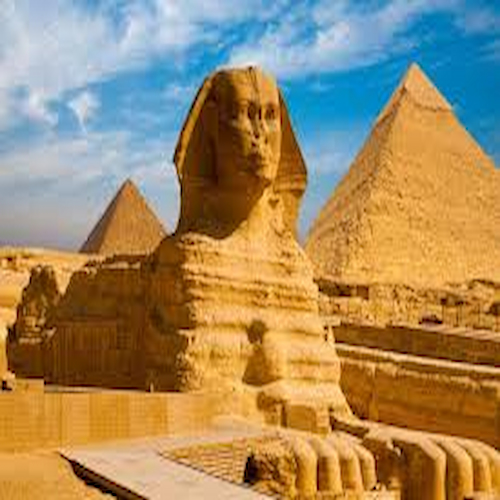The Pyramids of Giza are a testament to ancient engineering and cultural sophistication. They stand on the Giza Plateau near Cairo, Egypt, and have fascinated historians, archaeologists, and travelers for centuries. This article explores the historical significance of the Pyramids, the experience of touring them, recent developments in preservation and tourism, and the implications for the future.
Egyptian Tours, Giza Plateau Tours
The Giza Plateau is home to three main pyramids: the Great Pyramid of Khufu, the Pyramid of Khafre, and the Pyramid of Menkaure. The Great Pyramid, built for Pharaoh Khufu around 2580–2560 BCE, is the largest and oldest of the three. For over 3,800 years, it was the tallest artificial structure in the world, reaching a height of approximately 146.6 meters. The Pyramid of Khafre, slightly smaller, is noted for its well-preserved casing stones at the top, while the Pyramid of Menkaure, the smallest, is nonetheless an impressive example of ancient construction techniques. In addition to the pyramids, the site features the Great Sphinx, a monumental limestone statue with the body of a lion and the head of a pharaoh, often believed to represent Khafre himself.
The Pyramids
Touring the Pyramids of Giza offers visitors a unique opportunity to connect with history. Upon arriving at the site, tourists feel the overwhelming presence of the pyramids, which seem to grow larger as one approaches. Guided tours are widely available and can vary in depth and price. Tourists can choose to walk around the base of the pyramids or take camel rides for a different view. Each pyramid has its own set of internal chambers and shafts, where guided tours provide insights into the architectural marvels and burial practices of ancient Egypt.

How Old Are the Pyramids of Giza?
Due to the lack of evidence to date on the construction of the pyramids, the exact age of the Giza pyramids has been up for debate for a long time. The approximate date of the Khufu pyramid’s construction is 3200 B.C., according to history books. However, how precisely are the pyramids dated by Egyptologists? The current excavation at Giza, like previous ones, aims to help us determine the exact time period in which the pyramids were constructed. Two experts interviewed by NOVA Online discuss the findings of recent carbon dating on the pyramids and provide additional insight into the steps Egyptologists must take to determine how old these magnificent structures are.
Egyptian Tours: Learn Ancient Construction Methods
The experience of touring the pyramids is not limited to simply observing these majestic structures. The site offers a chance to learn about the construction methods employed by the ancient Egyptians. Current archaeological research suggests that the massive stones used in the pyramids were quarried locally and transported using a system of sledges and lubricated pathways, challenging previous theories of extreme labor or advanced machinery. Additionally, the precision of the pyramids’ alignment to the cardinal points is a testament to the sophisticated astronomical knowledge of the ancient Egyptians.
READ MORE: Building The Egyptian Pyramids: A Monumental National Project
Pyramids of Giza, New Discovery

Moreover, the Pyramids of Giza are not just relics of the past; they continue to inspire contemporary thought and innovation. In recent years, advancements in technology have allowed researchers to scan and map the pyramids using non-invasive techniques.
For example, the Scan Pyramids project, launched in 2015, utilized thermal imaging and muon radiography to explore the internal structures of the pyramids without damaging them. Such projects aim to uncover hidden chambers and understand the construction processes more deeply, potentially leading to new discoveries.
Egyptian Tours, Benefiting The Economy
The tourism industry surrounding the Pyramids of Giza plays a significant role in Egypt’s economy. Millions of tourists visit annually, drawn by the allure of ancient history and the mystery surrounding the pyramids. This influx of visitors generates revenue and provides jobs for local guides, vendors, and artisans. However, it is also crucial to balance tourism with preservation. Increased foot traffic, pollution, and urban development threaten the integrity of the pyramids. Recent efforts by the Egyptian government and various organizations have emphasized the importance of sustainable tourism. Measures include limiting the number of visitors at peak times, enhancing educational programs, and investing in conservation techniques.
Pyramids Of Giza, Conservation Efforts
Future implications for the Pyramids of Giza center around the need for responsible tourism and ongoing research. As interest in the site grows, it is essential to maintain a balance between accessibility for tourists and the preservation of the monuments. Continued investment in technology and conservation efforts will help protect these wonders for future generations. Moreover, engaging local communities in tourism and preservation initiatives can foster a sense of ownership and pride that benefits both the sites and their inhabitants.
Furthermore, as the global community grapples with issues such as climate change, the effect on archaeological sites, including the Pyramids of Giza, cannot be ignored. Rising temperatures and increased rainfall may pose risks to these ancient structures. To mitigate such risks, it is imperative to develop adaptive strategies that incorporate environmental science into archaeological conservation efforts.
Why Tour The Pyramids
Touring the Pyramids of Giza is a profound experience that connects modern visitors with one of civilization’s greatest achievements. These monumental structures offer insights into the history, culture, and engineering prowess of ancient Egypt. As tourism continues to flourish, it is vital to implement strategies that preserve the integrity of the site while promoting sustainable practices. The ongoing research and technological advancements contribute to our understanding of these fantastical creations and ensure that the
The pyramids of Giza remain a source of fascination and wonder for generations to come. As we look to the future, the pyramids stand not only as historical landmarks but also as symbols of humanity’s quest for knowledge and the enduring legacy of cultural heritage.



